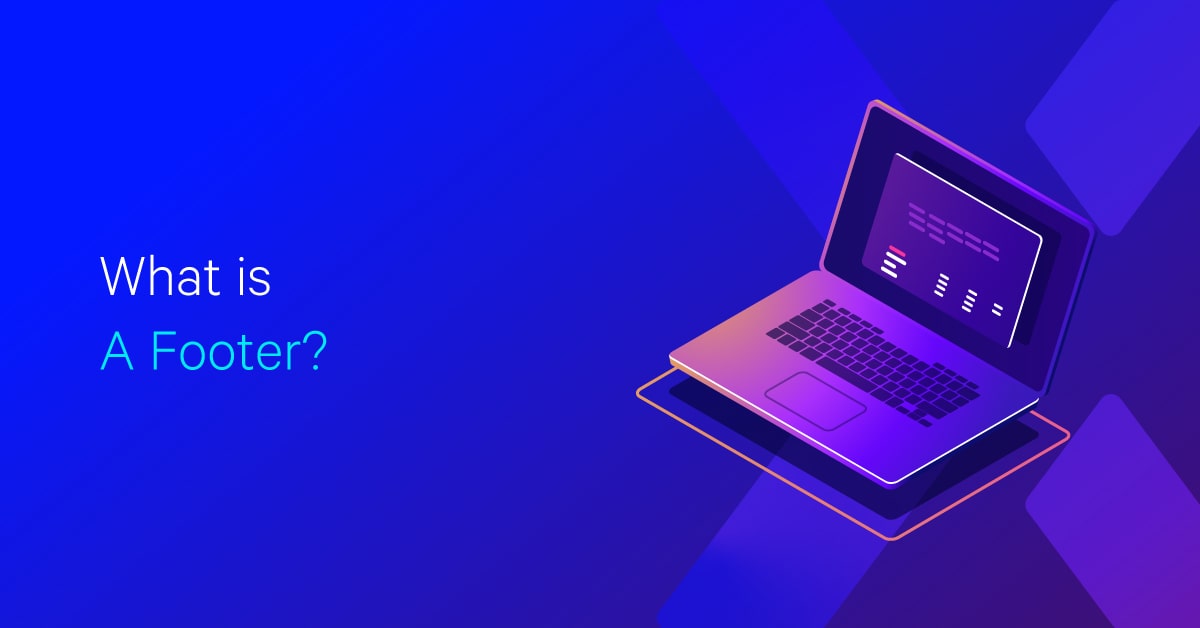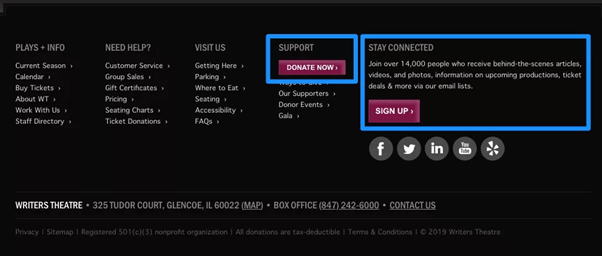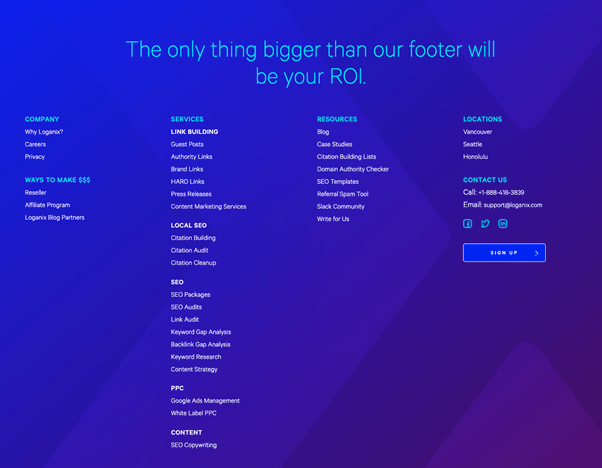What Is a Footer?

Hand off the toughest tasks in SEO, PPC, and content without compromising quality
Explore ServicesHave you ever been unable to find what you’re searching for in a website’s primary navigation? Have you ever looked at a product on an e-commerce site but couldn’t locate the return policy? The resulting irritation leads some visitors to abandon the site in search of one that is more transparent or straightforward.
This kind of user behavior is precisely why your website needs a well-designed website footer.
Consider a footer as a safety net for users who haven’t found the information they’re seeking in other areas of your site. You may prevent some users from leaving your eCommerce site and never returning by including a link to your return policy or contact form, for example.
In this article, we’ll cover what a footer is, its importance, and what to include in a footer to optimize for search.
First, let’s look at the definition of footer links.
What Is a Footer?
A footer is the content portion at the bottom of every page. A copyright notice, a link to a privacy policy, a sitemap, a logo, contact information, social networking icons, and an email sign-up form are all common elements found at the bottom of a page. In summary, a footer contains information that helps the overall usability of a website.
Footer links are classified as site-wide links, often known as boilerplate links.
These are links that appear on almost every page of a website. These are often header links, footer links, or links that show on the sides of a webpage (floating widgets, and so forth).
To easily access a page header or footer, just double-click on the grayed-out box containing the header/footer.
You may think that investing a lot of time and effort in the footer is pointless since visitors don’t pay attention to the content below the fold. Most scroll behavior studies, including one conducted by Neilsen Norman Group in 2018, validates this sort of reasoning. They discovered that 57% of the page-viewing time was spent above the fold.
However, time spent above the fold is diminishing with time, according to the research, as displays become larger, designers embrace simplicity, and scrolling becomes easier in general.
Given that footers provide navigation and informative purposes for your audience, it only makes sense to optimize this real estate for them despite its location at the bottom of the page.
Here’s an example of a footer:
And here’s another example of a footer (from a great SEO agency 😏) :
Why Is a Footer Important?
The footer of a website serves several functions, one of which is directly related to your website’s position and performance in organic search results.
Internal linking structure is critical for SEO as well as assisting visitors in navigating your website in a natural manner.
Google wants to know if you’ve placed footer links just for SEO purposes, or if they’re there to assist end-users in their navigation.
If Google judges that such links were included to assist people in navigating your website, they are considered a good item and will be crawled. If these links are placed only for SEO purposes, this will be seen negatively by Google and is something you should avoid at all costs.
If, for example, you have 100+ links in the footer section referring to different areas across the United States, you should reconsider your strategy.
Footers on websites enhance visibility. It gives the visitor vital information that is not readily available on the main menu (About, Blog, Contact Us).
From a commercial standpoint, you may use the footer section to advertise and promote previous and upcoming events, blogs, and social networking profiles. If your website provides valuable materials in the footer, it improves the user experience and encourages repeat visits.
Conversions Increased: Companies experienced a 50% boost in conversions after optimizing their footers. The footer is the final thing a visitor sees before leaving your website, so make sure it has enough information to entice them to remain and convert, join up, or purchase a product. Your footer can sometimes be the deciding factor between a sale and a bounce.
Viewership: According to one research, almost 66 percent of time spent on a website is spent below the fold (the part of the website that is not visible when it first loads). Many people are spending more time browsing at stuff that requires scrolling down to find. Most of them begin scrolling before the webpage has finished loading. As a result, the top of the page receives 20% fewer views than the footer.
Footer FAQ
What should be in a SEO footer?
A common trend in web design supports the construction of footers as part of their template with a lot of features and information. But here are a few rules of thumb:
- Be cautious with nofollows – virtually every website’s footer contains a few links that do not need to be followed, so consider if your terms of service and legal pages truly require the link juice you’re providing.
- Avoid stuffing keywords into anchor text.
- Make the links helpful and relevant.
- Organize links wisely rather than simply tossing them into a long list.
- Cross-linking is OK; however, it should be done naturally (and in such a way that a human reviewer would feel it is not purely for SEO purposes).
- To avoid being branded “manipulative” during a quality rater’s evaluation, make your footers appear beautiful and work properly.
It is critical to recognize that knowing what your visitors or subscribers are seeking is the sole need for developing a fantastic website footer and page layout. As a result, there is no exact recipe for a website footer. There are certain basic ingredients, but what you put in, the amount and the sequence are entirely up to you.
Let’s take a look at some of the elements you may safely include in your website’s footer content.
- Contact Information (phone number, address, etc)
- Copyright Information
- Disclaimer
- Call to Action (CTAs)
- Graphic Elements
- Opt-in form
- Sitemap
- Privacy Policy
- Terms of Use
- Social Media icons
- Membership Login
- Site Search Tool
- Awards and Certifications Association Memberships
- Testimonials
- Upcoming Events
Are footer links bad?
A site-wide footer link can and can help you rank a site, although it is weighted somewhat less than a single link on the same site’s home page (internal pages are unlikely to be as powerful).
Perhaps there is a figure in Google’s algorithm that states if X number of links to a site are produced in a short period of time, they are discounted. Alternatively, the home page link may have a positive value, while all following connections have a slightly negative value. The results are the same in either case — footer links can assist rank keywords.
It’s worth noting that I’d expect sites suffering from Penguin as a result of poor link tactics to benefit little from anything like this. If you already have a lot of unnatural link practices, a site-wide footer link is unlikely to help you.
Don’t worry if you’re a web developer who is reluctant to accept credit for your work. If you want to be completely secure and do not want the SEO advantage, add a “nofollow” tag to the link.
However, a good knowledge of who developed your products is part of branding, and I don’t believe we should be penalized for it. That doesn’t imply you should start building a slew of sites with footer links pointing to you — private blog networks are a whole other matter.
What is the purpose of a footer?
Website footer links have the potential to make or ruin your Google rating. Incorporating the appropriate number of links in your footer will assist users in navigating your site.
Mobile-friendliness: You must optimize your website for mobile use if you want to create and convert more leads on your website. It is simpler to browse on a phone, and footer links will assist customers in simply navigating across the page.
Redirection: Publishing high-quality, interesting content on your website can help you get more visitors. So, what do you want your viewers to do when they reach the end of your website? Looking for additional information? No. Give them even more! The links in your footer will guide your viewers to other pages on your website that they will find interesting.
More links equal a higher SEO ranking: Each and every link in your footer is analyzed for SEO ranking, so keep just the right amount available for visitors to follow.
Designing the Footer of Your Website
Hopefully, this article has given you a better understanding of what a footer is.
Linking is a vital part of SEO, as is what you do with the links in your footer.
The design of your website’s footer necessitates considerable consideration. It’s an area where people and search engine bots hunt for vital information that they can’t find anywhere else. You want to make sure you’re giving them the content and aspects they need so they can continue to explore your site rather than leaving in frustration.
If you discover another website linked to you in their footer, contact them and request that the link be removed. If that doesn’t work, utilize Google’s disavow tool to avoid fines.
Is your website not delivering the traffic, leads, or revenue that you want it to? Are you weary of your competition consistently ranking higher in Google than you? Are you establishing a new business and don’t know what you need to do to get started online? Then you might benefit from our managed SEO services.
Give us a call today.
Hand off the toughest tasks in SEO, PPC, and content without compromising quality
Explore ServicesWritten by Jake Sheridan on August 12, 2021
Founder of Sheets for Marketers, I nerd out on automating parts of my work using Google Sheets. At Loganix I build products, and content marketing. There’s nothing like a well deserved drink after a busy day spreadsheeting.





